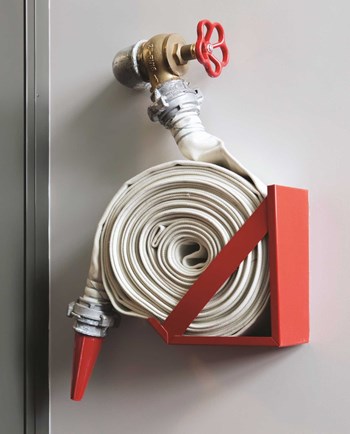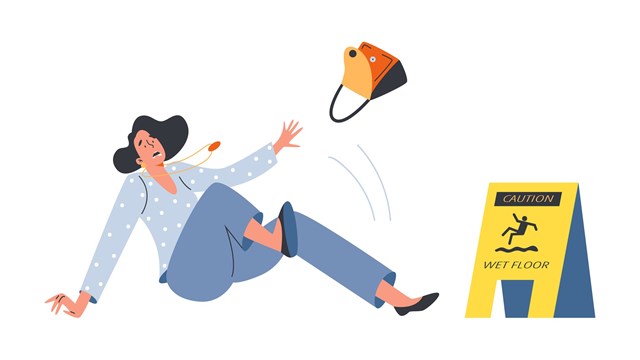
The discovery of fire is considered a major turning point in man's evolution from cave dweller to outer space explorer. Control of fire allowed early man warmth for his habitat, a way to cook his meals, and light for his surroundings. Fire also provided a means to frighten away predators and introduced a social element by bringing other humans together in a communal setting.
Harnessed and used for good, fire remains a wonderful tool for progress—but when out of control, flames are a deadly, devastating force. It is mankind’s best friend and fiercest enemy.
Fighting Fire...
The history of firefighting is probably as old as the element itself, but organized firefighting can be traced back to ancient Egypt where hand-operated pumps and bucket brigades were first employed to extinguish runaway flames.
Hand pumps and buckets were the state of the art in firefighting until 1672, when Dutch inventor Jan Van der Heiden invented the fire hose. Van der Heiden’s design was constructed of flexible leather coupled with brass fittings every 50 feet. The design was so perfect that the length and connections still remain the industry standard today.
The first fire engine appeared on the scene in 1725 and is attributed to Richard Newsham of London, England. Teams of men were employed to operate the manual pumps on specially designed horse-drawn carts when fire broke out. These early engines could deliver up to 160 gallons per minute at up to 120 feet in distance.
In this country, devastating fires in Jamestown and Boston inspired citizens to take greater measures towards combatting fires. By 1648, Fire Wardens were appointed to patrol most cities— specifically to inspect chimneys, where most fires started. If fire was spotted during the night watches, the wardens would rouse the citizens to form bucket brigades. Wooden chimneys and thatched roofs were eventually outlawed, and heavy fines levied on non-compliant citizens.
The first volunteer fire company in America, the Union Fire Company was created by Benjamin Franklin in 1736 in Philadelphia. George Washington was also a volunteer firefighter with the Friendship Veterans Fire Engine Company in Alexandria, Virginia. In fact, Washington bought and donated Alexandria’s first fire engine.
By 1850, full-time firefighters were employed in most cities, but even after the formation of paid fire companies, there were disagreements and fights over territories. The early fire companies were paid by insurance companies, and turf wars between responding units were common. Government-run fire departments first appeared around the time of the Civil War. Today, fire and rescue is often a mix of full-time paid, paid-on-call, and volunteer responders. Most major cities are served by large, paid, well trained firefighting teams.
Fire Prevention
If you ask any fire safety professional the best method for fire fighting, you will get the same answer: Prevention! Preventing a fire is the best possible way to insure protection of life and property. Even a small fire can create a life-threatening emergency and expensive property damage. Destruction is not limited to the flames, either. Smoke and water damage, damage from elevated temperatures, toxic fumes, and additional—and unavoidable—destruction caused by firefighting practices themselves all contribute to the final toll. According to the pros, there is no such thing as an insignificant fire.
Multifamily units, apartments and condominiums present additional challenges for fighting fires, protecting lives, and containing flames and smoke. Awareness, education and pre-planning by residents and HOA boards can go a long way towards prevention of fires.
Condominiums in Florida are considered privately-owned homes despite the fact that each unit is part of a multifamily building. “Enforcement of fire prevention regulations is laid in the hands of the condo or HOA boards,” says Battalion Chief Joel Gordon of the Plantation Fire Department in Plantation. “However, local officials do have jurisdiction over the common areas and life safety systems, throughout the building.”
Gordon also wears the public relations hat for his division and he stresses the fact that all local fire services will have a “pre-fire plan of action” for high rise buildings within their jurisdiction. When developing a prevention/evacuation plan for the building, the local fire department is always an excellent starting place for all boards and managers. “The board’s plan should mirror the fire department’s plan,” says Gordon.
Fire Marshal Frank Scates in the Brevard County Fire Rescue Office of Fire & Life Safety concurs with Gordon. “Most local fire prevention offices will consult with an HOA board either free of charge or for a minimal fee,” he says. Scates' office provides a sample Fire Safety Checklist for properties to adapt and customize. The list has both annual and monthly safety maintenance guidelines, and provides a ready, user-friendly reference in a simple format.
If there are residents requiring special assistance in the event of fire or other emergency, it is imperative to have an evacuation plan in place ahead of time. Contingencies to be considered should include the need for any devices and/or personal assistance. Sheltering in place, or an area of safe refuge should also be evaluated depending on the emergency. When fire is involved, smoke can be as deadly as the flames, and sheltering in place may not be an option.
All condo and HOA boards should have a copy of the Florida laws and ordinances governing fire safety in high-rises and condominiums. This information is available in the Florida Fire Prevention Code, 2010-NFPA (National Fire Protection Agency) 101, chapters 30 and 31.
Once a board is conversant on the law, sharing it with the residents is imperative. How and when this information is shared will vary by property, but newsletters and open meetings are generally an excellent way to educate building residents. The evacuation plans should also be reviewed at least annually and updated as required.
Getting Out, Staying Alive
“An effective evacuation plan will have a number of components,” says Gordon.”All residents should know two exits out of their unit.” For most condo residents this is often either direction down the hallway; windows and back exits are seldom an option and particularly in a high-rise building.
In the event of fire, a resident should always feel the unit door before opening it to the common hallway. If the door is cool to the touch, the door may be opened slowly; if there is smoke present in the hallway the door should be closed immediately. A wet bath towel may be placed firmly along the inside of the door, and the fire department should be called immediately. A resident may then open a window and have a towel or scarf to signal the location of the unit and alert the fire and rescue team.
If the door is cool to the touch and there is no smoke, a resident may move quickly but safely to the designated fire exit. It may be necessary to stay low or even crawl, and visibility may be limited if smoke is encountered. A damp towel is excellent to protect your nose and mouth in the event of smoke. Any fire alarm box encountered along the exit route should be activated to further alert both residents and rescue team members. Scates recommends residents exiting the building also knock on any doors and yell “FIRE!” as they move towards safety. “The fire alarm will not notify the fire department,” cautions Scates, “you must also dial 911 after you have evacuated the building.”
“Never use the elevators,” adds Gordon. “And have a prearranged meeting place outside of the building for friends, and family members to meet, and never under any circumstance return to the building.” Scates also points out three familiar warnings if you come in contact with actual flames, “Stop, drop and roll if your clothing catches fire.”
Gordon also cautions residents not to try fighting a fire personally. “Fire extinguishers and hose cabinets are for clearing an exit for yourself—not for fighting a fire.” It's imperative that boards and managers make clear to residents that their only job is to get safely out of the building. Scates echoes that advice, and reminds residents to always contact emergency personnel if you suspect someone is missing or trapped in the building; never try to perform a rescue yourself.
An important part of fire prevention is proper property maintenance. Faulty wiring, aging hot water heaters, and air conditioning units can all contribute to fire hazards. The Life Safety Systems including smoke alarms, sprinklers, and exit lightning must also be maintained and checked on a regular basis.
Gordon has a short list of “don’ts” for residents. “Don’t use candles or open flames,” he cautions. “Avoid extension cords, check to ensure cook tops and burners are in the off position, and if you smoke, do so responsibly—and never in bed.” From his experience, Gordon says that most multifamily dwelling fires are small, usually contained in one unit due to South Florida’s block construction for high rises, with smoke damage migrating into common areas being the worst case scenario.
Gordon typically sees only one or two fires annually that spread between units or floors, and the cause is also limited to three or four main situations; electrical, kitchen-related, carelessness with candles or smoking and juveniles playing with matches.
Like Gordon, Jeanine T. Green, Public Education Specialist with Hillsborough County Fire Rescue in Tampa finds the primary causes for fires in her region to be either electrical or cooking-related. She also notes heating equipment as an additional culprit. “While cooking fires are the number one cause of injuries, smoking is the leading cause of death,” reports Green.
In 2010, there were 151 fire deaths reported in the State of Florida. People age 41 and older accounted for 75.5 percent of the fatalities and 8 percent (4,647) of all reported fires were in multi-family dwellings.
Green recommends HOA and condo boards take a two pronged approach to fire preparedness: 1) to have a detailed emergency action plan (EAP) for what to do when a fire occurs; and 2) to have a fire prevention plan describing what to do to prevent a fire.
In order to develop a viable prevention and evacuation procedure, Green recommends HOA and condo boards utilize creditable web site information such as The Florida Fire Marshal Annual Report, at http://www.myfloridaacfo.com and the National Fire Protection Agency at, http://www.nfpa.org, and the CDC at http://www.cdc.gov/homeandrecreationalsafety/fire-prevention/fires-factsheet.ht ml.
After a thorough review of the online resources, a board may decide to consult a professional with real-life working knowledge, training, expertise and past emergency experiences. “Fire Safety Consultants work under state and local laws, ordinances, and safety codes.” “There are many variables to consider,” says Green, “and costs may well vary.” “You may want to view, critique, and consider other communities procedures and then customize them to the unique needs of your own community.”
In addition to human life, pets may pose a very real evacuation concern for associations that allow pets. Green recommends this issue be addressed if applicable, and worked into the EAP for the property.
The level of community involvement desired in the planning and preparation for emergency action will ultimately be a board decision. However, once those plans are in place all residents should be made aware of the details by the accepted method of community communication and updates and reviews should occur on a regular basis in order to ensure the health, safety and peace of mind of both residents and board members.
Anne Childers is a freelance writer and a frequent contributor to The South Florida Cooperator.






Leave a Comment